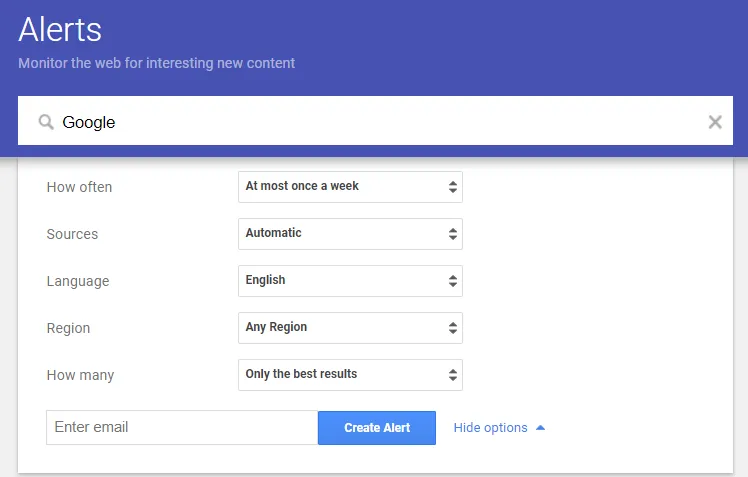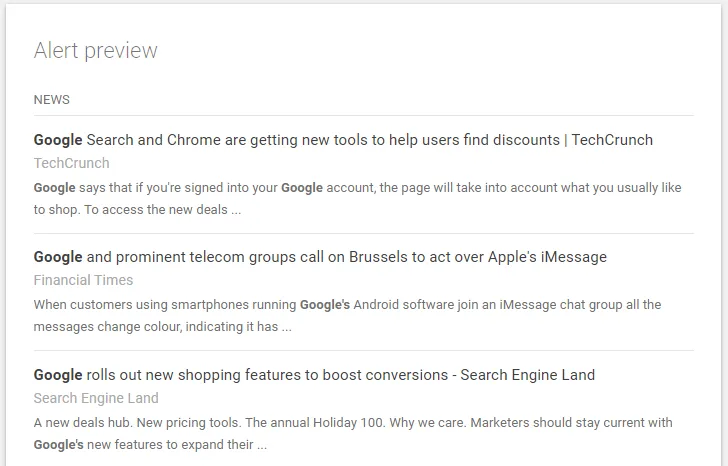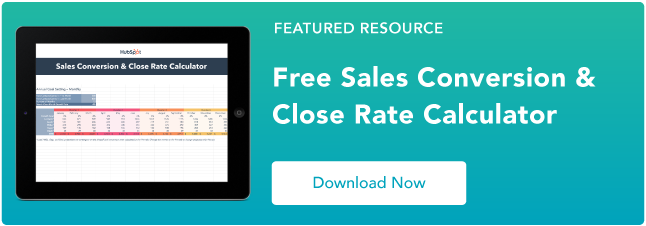Table of Contents
- What is a Google Alert?
- How Google Alerts Can Lead to Sales
- How to Create a Google Alert
- Google Alerts for Sales: A Tailored Approach Works Best
What is a Google Alert?
A Google Alert is a free way to track newly indexed results for specific phrases or terms as they appear within Google Search. With an alert, you‘ll receive fresh content related to your chosen term(s) via email. There’s a plethora of reasons people decide to set up these alerts. However, typical uses include tracking news related to specific companies, topics, or products.
“Cool, but why does this matter for my sales strategy, Rachael?” Great question, reader. In case you didn't know, Google owns over 91% of the global search engine market.
Bottom line? If you want the best sales insights related to your competition and target audience, you‘ll likely find them through Google Search. And a Google Alert means you’ll get all the intel sent to your inbox.
How Google Alerts Can Lead to Sales
From personalizing sales letters to tracking brand mentions, here are six ways experts use Google Alerts to help them sell.
.webp)
Personalize sales letters.
“In complex B2B sales cycles, a personal sales letter—some even call it Exceptional Credibility Letter (ECL)—is still a tactic to be used early on,” says the Head of Operations at Goose‘n’Moose, Hristina Stefanova.
Stefanova explains that, unlike cold outreach, personal letters are 100% tailored to one prospect and cannot be used to reach another.
When it comes to structuring your ECL, paragraph one is all about the prospect. That includes “their challenge, recent company issue, or something else that has triggered the ECL in the first place,” Stefanova continues.
Stefanova recommends using Google Alerts to inspire every first paragraph of your personal sales outreach.
Pro tip: “Name the top 20 accounts you want to sell to, find their key people, and set up Google Alerts for all of them,” says Stefanova. “Sooner or later, a news piece will make you connect the dots between what's high on their agenda and your own solutions.”
Track brand mentions.
“So from a sales point-of-view, I'd definitely set up Google Alerts for brand mentions,” says Founder and SEO Strategist at Growth Winner LLCUmar Faizan. In this case, you'd set a Google Alert for instances where people mention your brand name specifically.
Faizan explains that once you've set up Google Alerts to track brand mentions, “Whenever someone talks about your product or service online, you can instantly engage with them, sometimes turning a casual mention into a sale.”
Track transactional keywords and phrases.
Google Alerts can also “sniff out new markets or advertising spaces for you,” Faizan continues. You can do this by targeting “industry-specific keywords to find out where the conversations are happening.”
You can then strategically place your offerings in the right place at the right time (i.e. when you get an alert).
“If not keywords, you can set up alerts for specific industry jargon or needs — like 'need a CRM solution,'” says Faizan.
Umar recommends using this approach to potentially find customers already in the funnel but not yet committed to a competitor.
Pro tip: Buyers want to hear from salespeople early in the buying process. They‘re also more likely to accept meetings when salespeople reach out first. So don’t be shy about setting these kinds of sales alerts.
Monitor competitor backlinks.
“Back in 2008, I was working for Funky Pigeon in Bristol, and I saw on Twitter about 'Google Alerts,'” says Nina Payne, a SEO freelancer and consultant at SEO Lady. After seeing the tweet, Payne set up a Google Alert to Funky Pigeon's main competitor, Moonpig.
“Every time Moonpig posted, I'd get an email,” says Payne. “This allowed me to learn blow by blow which websites were giving them backlinks, press releases, new pages added, and mentions in the media.”
Insights about your competitor's backlinks can help you tailor your link-building strategy in a way that helps your transactional pages rank better. Given that only 0.63% of people click on results from the second page of Google, your organic product visibility matters.
The more effective your link-building campaign (i.e., the more high-quality and relevant backlinks you earn), the higher your transactional pages will likely appear in search. More visibility equals more potential for clicks and sales.
Pro tip: Payne recommends also using your own name as an [exact match] Google Alert just in case anyone mentions you in an article. Plus, by adding your domain, you can see how effective your link-building has been.
Monitor competitor’s pricing changes.
“In my experience, monitoring competitors' pricing changes through Google Alerts has been a huge help to our sales strategy,” says David Godlewski, CEO of Intelliverse.
Godlewski recommends setting up alerts with unique keyword combinations that include competitor names, product names, and terms like price reduction or discount. This will help you receive real-time notifications when your rivals adjust the pricing for their flagship products or services.
“When competitors lower their prices, we receive an immediate alert and strategically analyze whether matching or undercutting their prices is viable,” Godlewski explains. “This keeps us competitive, helps us regain market share during a slow month, and demonstrates our commitment to offering the best value to customers.”
Connect with leads more purposefully.
"Every time you source or decide to start working a lead, you should create a Google Alert for the company," says former Principal Sales Rep at HubSpot Ali Powell. “Setting up an alert probably takes three seconds, tops. So I'd encourage you to do this every single time you start to work a lead. Make it part of your process.”
Powell explains that these notifications will help you discover more (and better) reasons to reach out to your leads other than the generic just following up or just checking in.
“These types of messages aren't great because you have nothing valuable to say to the prospect,” Powell continues.
Pro tip: “Don't be self-serving — set up Google Alerts for your leads so you can reach out when it's a good time for them, not you,” warns Powell. “And when I say create an alert for every lead, I mean it. You should see what the Google Alerts folder looks like in my Gmail — it's huge.”
How to Create a Google Alert
I'm going to use Ali Powell’s use case for generating leads to walk you through the process of setting up a Google Alert.
Step 1: Head to Google Alerts.
First, go to Google Alerts and search for your lead. I will keep it simple and use ‘Google’ as an example.

Step 2: Preview the results.
Once you type in your term, Google will show you some search results of recent articles and/or web pages indexed with those keywords or that company‘s name. This gives you a preview of the type of content you’ll receive via email based on this alert.
If you‘re doing something other than monitoring a lead through a brand name, I’d recommend scanning through these initial results. You can then make sure the results (and, therefore, the query) actually match your needs.
If the content won‘t be helpful, I’d recommend trying new terms and phrases until you get more relevant content.
Step 3: Set Your preferences.
Clicking ‘Show options’ allows you to set the finer details, including alert frequency.
I will choose weekly because daily would be too overwhelming for me. But a week's worth of information would work with my schedule and give me enough content to determine the juiciest insights for prospecting outreach.

However, if you have the resources to be more timely in your responses, setting the frequency to daily might be better. At the end of the day, it depends on your goal for the alerts.
Step 4: Create your alert and set up an email folder.
Now, simply enter your email address and click “Create Alert.” That's it!
.webp)
Expert insight: Powell recommends setting up a folder in your email inbox labeled Google Alerts and directing all of the alerts to be sent there.
“This will create a single repository for your alerts so they don't clutter up your inbox,” says Powell.
Step 5: Using Your Google Alerts
When you have time to go through these alerts, you‘ll find relevant information about the leads and opportunities you’re following. These so-called trigger events will shape how you reach out to your leads moving forward.
Expert insight: "Make sure to add this information to your notes (in your CRM software, note-taking app, or good old paper notebook) on the lead or opportunity," says Powell. “With all your newfound knowledge in one central place, it'll be easier to act on it in a smarter, more timely way.”
Google Alerts for Sales: A Tailored Approach Works Best
Overall, I found it easy to set up the Google Alert. I can also see how this would be a beneficial sales activity — especially if you have specific leads you‘d like to contact in a meaningful way. Although you may not have the time to comb through piles of alerts, it’s worth the effort, thanks to the insights you'll gain.
That said, Google Alerts don‘t automatically lead to sales. I’d suggest taking a targeted approach to avoid ending up with an inbox full of junk. If your chosen term(s) don't offer you relevant insights, I suggest improving in iterations. So try different variations on your approach until the results of your Google Alert improve.
Sales Prospecting
.png?width=112&height=112&name=Sales%20Conversion%20and%20Close%20Rate%20Calculator%2001-300%20(1).png)



.webp)






![How to Find Almost Anyone’s Email Address, Without Being Creepy [+Expert Tips]](https://53.fs1.hubspotusercontent-na1.net/hubfs/53/132_Find%20Email%20Address.jpg)

